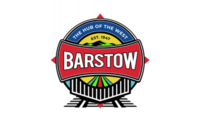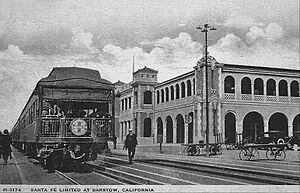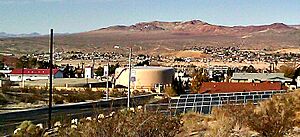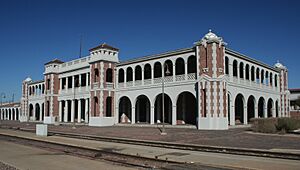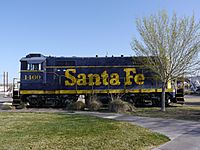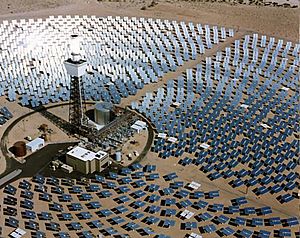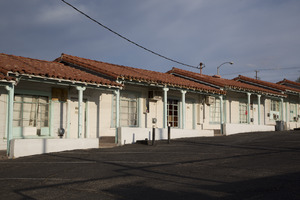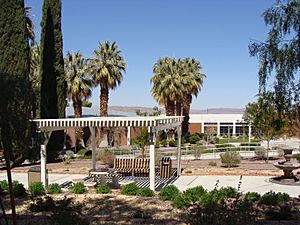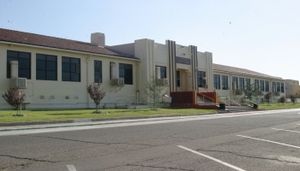Barstow, California facts for kids
Quick facts for kids
Barstow, California
|
|||
|---|---|---|---|
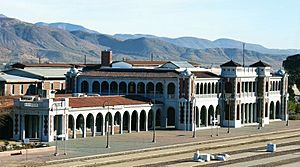
|
|||
|
|||
| Motto(s):
"Crossroads of Opportunity"
|
|||
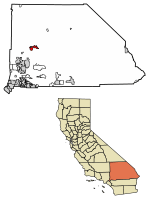
Location of Barstow in San Bernardino County, California
|
|||
| Country | |||
| State | |||
| County | San Bernardino | ||
| Incorporated | September 30, 1947 | ||
| Named for | William Barstow Strong | ||
| Government | |||
| • Type | Council-manager | ||
| Area | |||
| • Total | 41.34 sq mi (107.08 km2) | ||
| • Land | 41.30 sq mi (106.96 km2) | ||
| • Water | 0.04 sq mi (0.11 km2) 0.02% | ||
| Elevation | 2,175 ft (663 m) | ||
| Population
(2020)
|
|||
| • Total | 25,415 | ||
| • Density | 615.39/sq mi (237.60/km2) | ||
| Demonym(s) | Barstonian | ||
| Time zone | UTC−8 (Pacific Time Zone) | ||
| • Summer (DST) | UTC−7 (PDT) | ||
| ZIP Codes |
92311–92312
|
||
| Area codes | 442/760 | ||
| FIPS code | 06-04030 | ||
| GNIS feature IDs | 1652670, 2409790 | ||
Barstow is a city in San Bernardino County, California. It is located in the Mojave Desert in Southern California. In 2020, about 25,415 people lived there. Barstow is an important meeting point for roads and trains. It is also home to Marine Corps Logistics Base Barstow.
Contents
History of Barstow

People have lived in the Barstow area for a very long time. Native American tribes lived here as far back as 3,000 years ago. They hunted, fished, and traded turquoise.
The first written records of the Mojave Valley are from the 1700s. A Spanish friar named Francisco Garcés explored the area. He followed old pathways through the Mojave River Valley and the desert around Barstow. He was on his way to Spanish missions in California.
How Barstow Started
Barstow began to grow in the late 1840s. This was part of the Mormon Corridor, a route used by settlers. During cooler months, people, goods, and animals traveled from New Mexico and Utah to Los Angeles. They used trails like the Old Spanish Trail or the Mormon Road.
These travelers followed the Mojave River. They often stopped for water and camped at places like Fish Ponds or Grapevines. In 1859, the Mojave Road was created. It connected Los Angeles to Fort Mojave through Grapevines.
Later, there were some conflicts with local tribes. From 1860, Camp Cady, a U.S. Army post, was sometimes used by soldiers. It was about 20 miles (32 km) east of Barstow. Trading posts were set up at Grapevines and Fish Ponds. They supplied travelers and miners.
Railroads and Highways
Barstow's growth is also linked to mining. Gold and silver were found in the Mojave Desert in the 1860s and 1870s. Railroads were built to move goods and people. The Southern Pacific built a line through Barstow in 1883. In 1884, the Santa Fe Railroad took over part of this line.
Paving major roads helped Barstow grow even more. The city's economy relies a lot on transportation. Before the interstate highways, Barstow was a key stop on U.S. Route 66 and U.S. Route 91. These two routes met in downtown Barstow. Today, Interstate 15 and Interstate 40 are the main highways.
Barstow is named after William Barstow Strong. He was a former president of the Atchison, Topeka and Santa Fe Railway. Some older names for Barstow were Camp Sugarloaf, Grapevine, Waterman Junction, and Fishpond.
Geography and Climate
Barstow covers about 41.34 square miles (107.08 square kilometers). Most of this area is land.
Barstow's Weather
Barstow has a arid climate, which means it's very dry. It has four seasons. Summer days are usually very hot, often over 100°F (38°C). Winters are cold in the mornings, with temperatures around 30°F (-1°C). The temperature can change a lot between day and night.
On average, Barstow gets about 4.96 inches (12.6 cm) of rain each year. Most of the rain falls in the cooler months, from November to April. Snow is rare in winter. Many years pass without any snow.
| Climate data for Barstow, California, 1991–2020 normals, extremes 1903–present | |||||||||||||
|---|---|---|---|---|---|---|---|---|---|---|---|---|---|
| Month | Jan | Feb | Mar | Apr | May | Jun | Jul | Aug | Sep | Oct | Nov | Dec | Year |
| Record high °F (°C) | 83 (28) |
87 (31) |
93 (34) |
99 (37) |
107 (42) |
114 (46) |
120 (49) |
113 (45) |
113 (45) |
102 (39) |
91 (33) |
86 (30) |
120 (49) |
| Mean daily maximum °F (°C) | 59.0 (15.0) |
62.8 (17.1) |
69.7 (20.9) |
76.9 (24.9) |
85.7 (29.8) |
96.0 (35.6) |
102.1 (38.9) |
101.0 (38.3) |
93.3 (34.1) |
80.9 (27.2) |
67.5 (19.7) |
57.4 (14.1) |
79.4 (26.3) |
| Daily mean °F (°C) | 47.1 (8.4) |
51.1 (10.6) |
57.0 (13.9) |
63.1 (17.3) |
71.3 (21.8) |
80.5 (26.9) |
86.9 (30.5) |
85.7 (29.8) |
78.3 (25.7) |
66.8 (19.3) |
54.5 (12.5) |
46.2 (7.9) |
65.7 (18.7) |
| Mean daily minimum °F (°C) | 35.3 (1.8) |
39.4 (4.1) |
44.2 (6.8) |
49.4 (9.7) |
56.9 (13.8) |
65.0 (18.3) |
71.8 (22.1) |
70.4 (21.3) |
63.3 (17.4) |
52.6 (11.4) |
41.6 (5.3) |
34.9 (1.6) |
52.1 (11.2) |
| Record low °F (°C) | 3 (−16) |
11 (−12) |
19 (−7) |
28 (−2) |
34 (1) |
40 (4) |
48 (9) |
48 (9) |
32 (0) |
21 (−6) |
14 (−10) |
8 (−13) |
3 (−16) |
| Average precipitation inches (mm) | 0.76 (19) |
0.98 (25) |
0.59 (15) |
0.30 (7.6) |
0.06 (1.5) |
0.04 (1.0) |
0.26 (6.6) |
0.17 (4.3) |
0.25 (6.4) |
0.35 (8.9) |
0.40 (10) |
0.80 (20) |
4.96 (126) |
| Average snowfall inches (cm) | 0.0 (0.0) |
trace | 0.0 (0.0) |
0.0 (0.0) |
0.0 (0.0) |
0.0 (0.0) |
0.0 (0.0) |
0.0 (0.0) |
0.0 (0.0) |
0.0 (0.0) |
0.0 (0.0) |
0.3 (0.76) |
0.3 (0.76) |
| Average precipitation days (≥ 0.01 in) | 3.9 | 4.2 | 2.6 | 1.3 | 0.8 | 0.2 | 1.5 | 0.9 | 0.8 | 1.1 | 1.6 | 3.0 | 21.9 |
| Average snowy days (≥ 0.01 in) | 0.0 | 0.1 | 0.0 | 0.0 | 0.0 | 0.0 | 0.0 | 0.0 | 0.0 | 0.0 | 0.0 | 0.1 | 0.2 |
| Source: NOAA/WRCC (1903–1980 records) | |||||||||||||
Plants in Barstow
The natural plants in Barstow are mostly desert shrubs like creosote bush. People living in the city have planted many trees that are not native to the area. These include Aleppo pine, Morus alba, and Italian cypress.
People and Population
| Historical population | |||
|---|---|---|---|
| Census | Pop. | %± | |
| 1950 | 6,135 | — | |
| 1960 | 11,644 | 89.8% | |
| 1970 | 17,442 | 49.8% | |
| 1980 | 17,690 | 1.4% | |
| 1990 | 21,472 | 21.4% | |
| 2000 | 21,119 | −1.6% | |
| 2010 | 22,639 | 7.2% | |
| 2020 | 25,415 | 12.3% | |
| 2022 (est.) | 25,231 | 11.4% | |
| U.S. Decennial Census | |||
Barstow's Population in 2010
In 2010, Barstow had 22,639 people. About 98.4% of the people lived in homes. There were 8,085 households. About 39.5% of these households had children under 18. The average household had 2.75 people.
The population included many different groups. About 52.3% were White, 14.6% African American, and 2.1% Native American. About 42.8% of the people were Hispanic or Latino.
About 29.8% of the people were under 18 years old. The average age in Barstow was 31.1 years.
Arts and Culture in Barstow
Barstow has many colorful murals along Main Street. These murals show scenes from the city's history. They were created by a local group called Main Street Murals.
The Barstow Branch Library offers fun activities for the community. These include a summer reading program for kids and story times.
Fun Things to Do
The Skyline Drive-In is an old-fashioned drive-in theater. It's one of the last ones still open in San Bernardino County. It has two screens that show movies every night.
The Hollywood Theatre Barstow Cinema 6 is the city's indoor movie theater. It has six screens. Barstow Community College also has a Performing Arts Center. It hosts college plays and music shows.
Barstow Museums
Barstow has several museums. These include the Mojave River Valley Museum and the Route 66 Mother Road Museum. There is also the Western America Rail Museum and the Desert Discovery Center. The Old Woman meteorite, a very large meteorite, is at the Desert Discovery Center.
The Casa Del Desierto was built in 1911. It was a hotel and train station. Today, it holds the Route 66 Mother Road Museum and the Western America Railroad Museum. It is still an Amtrak train station.
Barstow Station
Barstow Station opened in 1975. It looks like a railway station. Many tour buses stop here, about 20,000 each year. It has gift shops, places to eat, and a Greyhound bus terminal. The McDonald's restaurant at Barstow Station is made of three old railroad cars. This is a nod to Barstow's history with trains.
Shopping in Barstow
Southwest of Barstow is the Tanger Center Barstow. It's a popular place for tourists traveling between Los Angeles and Las Vegas. There's also an older shopping center called Barstow Factory Outlet.
The city has an indoor shopping mall, Barstow Mall. It was built in the 1970s and updated in 2010.
Places Near Barstow
The United States Army's National Training Center (NTC) is north of Barstow. NASA's Goldstone Deep Space Communications Complex is also nearby. This complex has a special antenna called the Pioneer Deep Space Station. It is a U.S. National Historic Landmark.
Calico Ghost Town is an old mining town. It is now a museum. Rainbow Basin is another interesting place. It has colorful rock formations and canyons. People visit to hike, camp, and take pictures.
Coyote Dry Lake is a large dry lake about 15 miles (24 km) northeast of Barstow. You can also explore lava tubes near Pisgah Crater. The Solar Project is located about 10 miles (16 km) east of Barstow.
Sports in Barstow
Barstow used to have a semi-professional football team called the Barstow Riffians. The city also has adult basketball and softball leagues.
Barstow Community College has four sports teams. They play men's and women's basketball, baseball, and softball.
Parks and Recreation
Barstow has two main parks. The Barstow Skate Park is a large skate park. The Robert A. Sessions Memorial Sportspark has six lighted ball fields, soccer fields, and basketball courts. It also hosts softball tournaments.
The city also has the Dana Park Community Center and the Cora Harper Fitness Center. The Eda Henderson Pool is open during the summer.
The Barstow Senior Center helps seniors in the community. It offers daily activities and has a thrift store.
Economy of Barstow
Barstow is far from big cities, which can create economic challenges. The city is working on new projects to help its economy grow. There are plans for new stores, hotels, and other businesses.
In 2022, BNSF, a large railroad company, announced plans to expand its rail yard in Barstow. This project, called the Barstow International Gateway, will cost 1.5 billion dollars. It will help move goods faster from the Port of Los Angeles. Because of this, Barstow changed its motto to "the Hub of the West."
Main Employers in Barstow
Here are the top employers in Barstow in 2020:
| # | Employer | # of Employees |
|---|---|---|
| 1 | Ft. Irwin National Training Center | 8,900 |
| 2 | Marine Corps Logistics Base | 1,700 |
| 3 | BNSF Railroad | 1,000 |
| 4 | Barstow Unified School District | 958 |
| 5 | Outlets at Barstow | 480 |
| 6 | Raytheon Tech Services | 400 |
| 7 | Barstow Community College | 377 |
| 8 | Barstow Community Hospital | 348 |
| 9 | Walmart | 305 |
| 10 | Silver Valley Unified School District | 300 |
Education in Barstow
The Barstow Unified School District has several elementary schools for grades 1–6:
- Cameron Elementary School
- Crestline Elementary School
- Henderson Elementary School
- Lenwood Elementary School
- Montara Elementary School
- Skyline North Elementary School
- Thomson Elementary School (now Barstow Stem Academy)
Students in grades 7–8 go to Barstow Junior High School. Grades 9–12 attend Barstow High School. There are also charter schools like Excelsior Charter Schools and Mojave River Academy.
Barstow Community College is the only college in the area. It helps students prepare to go to a four-year university. It also teaches job skills through career technical education.
Media and Entertainment
Local News and Radio
The Desert Dispatch is Barstow's local newspaper. It started in 1910. Barstow's main radio station is KDUC, also known as "K-DUCK." It plays adult contemporary music.
Barstow in Movies and TV
Barstow has a special film office to help movie makers. Many famous movies have been filmed in the city. These include Broken Arrow, Erin Brockovich, and Kill Bill: Volume 2.
Barstow is also mentioned in the movie Fear and Loathing in Las Vegas. The movie The Hangover mentions Barstow before a road trip to Las Vegas. The character Blinkey, from the 80s alien show ALF, is said to live in Barstow.
Music About Barstow
Many songs mention Barstow. "Barstow Cowboy in Old Barstow" was a 1941 song by Spike Jones. Barstow is also in the lyrics of the famous song "Route 66".
Composer Harry Partch wrote a piece called "Barstow." It was inspired by graffiti written by hitchhikers in the city. The Residents' song "Death in Barstow" tells a story about two friends in Barstow. Bill Morrissey's song "Barstow" talks about how cold it can get there.
Sheryl Crow's song "Leaving Las Vegas" mentions spending the night in Barstow. The band Goodnight, Texas has a song called "Barstow" about a gold miner.
City Services
Getting Around Barstow
Victor Valley Transit Authority provides local bus service in Barstow. It has three city bus routes and a service for seniors and people with disabilities. There are also county routes to nearby towns. All city and county buses meet at the Barstow City Hall Transport Center.
Long-distance buses like Greyhound also serve Barstow. The Harvey House Railroad Depot is a train station. Amtrak's Southwest Chief train stops there twice a day.
Barstow-Daggett Airport is a local airport for small planes. It does not have commercial flights. The main roads in Barstow are Interstate 40, Interstate 15, and California State Route 58.
Healthcare in Barstow
Barstow Community Hospital is a hospital with 30 beds. It serves the local High Desert community. It offers inpatient, outpatient, medical, surgical, and emergency care.
Cemetery
The Mountain View Memorial Park is a cemetery in Barstow. It was started in 1937.
Famous People from Barstow
- Nick Barnett, former NFL player
- Raquel Beezley, Miss California USA 2008
- Jeanne Crain, actress
- Dino Ebel, Major League Baseball coach
- T. J. Houshmandzadeh, former football player
- Spoon Jackson, poet
- Byron Katie, author and speaker
- Joe A. Martinez, sports announcer
- Michael Pelkey, founder of BASE Jumping
- Scott Reeder, drummer
- Stan Ridgway, musician
- Ross Robinson, music producer
- Gloria J. Romero, former California State Senate leader
- Paul Salopek, journalist
- Aaron Sanchez, MLB pitcher
- Rick Steves, travel author and TV personality
See also
 In Spanish: Barstow (California) para niños
In Spanish: Barstow (California) para niños


